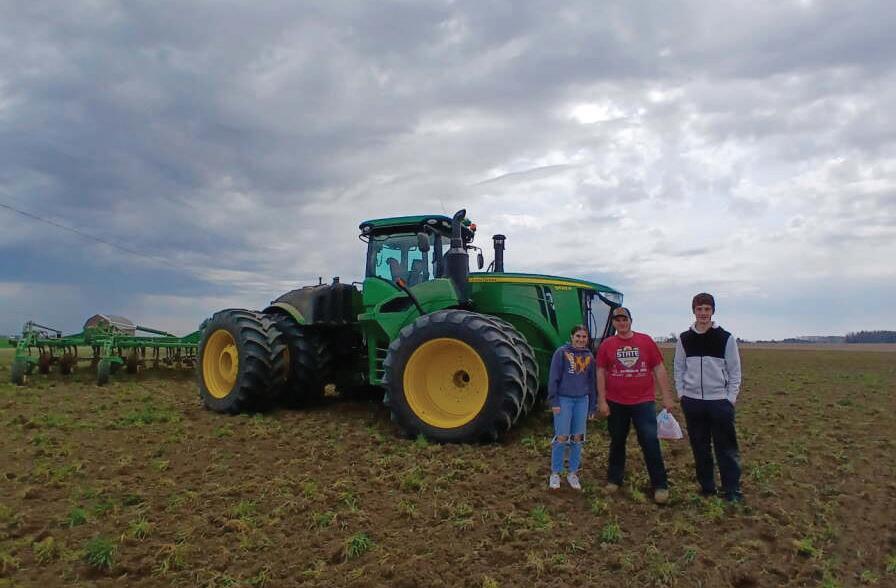














































Jhyrah DeLapp Staff writer
North Huron FFA delivered 60 packaged meals to local farmers, growers and food-industry professionals who were nominated by FFA members and through submissions on social media.
The meals were prepared and delivered Friday, April 25.
administrator Haley Talaski. “Our officer team puts together all of the meals into takeout containers, and then two or three members go out with one of the advisors—either myself or Nicole — and deliver them to the nominees.”
Some ingredients in the meals came from FFA extracurricular projects.
“Mark Polega and our kitchen staff make the meals for our farmers and for our school on Friday,” Talaski said. “He uses chicken from our fall broiler project, potatoes from our community garden, corn, salad and always a great dessert. They do a great job, and we appreciate his help in making this happen.”



“We were very thankful because it’s a very busy time of year for us,” said Lisa Szymanski of Szymanski’s Creekside Acres. “We were getting ready to head to the field, so the delivered meal made my life so much easier. It was one less thing I had to worry about that day. We’re also really grateful for their acknowledgment and appreciation of agriculture in the community and for supporting local farmers.”
North Huron FFA has run the “Thank a Farmer” initiative for the past five years.
“It started as a way for our program to recognize and show appreciation for all the things farmers do to put food on our tables,” said North Huron FFA
The meals were not only provided to those in agriculture and food-related industries—they were also served to the whole school.
“We do our Farm to Fork lunch at the same time,” Talaski said. “It’s the same meal. Our whole school and staff get the same lunch. The 60 meals were just the ones that got delivered.”
To be eligible for a delivered meal, nominees had to reside within the North Huron School District.
Katy Snodgrass Staff writer
A Huron County student’s passion for agriculture and commitment to academic excellence has earned her a prestigious GreenStone Farm Credit Services scholarship, a program created to honor former President and CEO Dave Armstrong’s legacy of investing in the future of the agricultural industry.
Out of 36 applicants, four students were chosen for a 2025 scholarship, and one of those students is Ubly's Abigail Guza, daughter of Christopher Guza.
Guza currently attends Michigan State University, where she is pursuing a degree in crop and soil sciences. While studying there, she also works in MSU’s Pedology Laboratory, compiling and making soil testing data from Michigan counties accessible for public use.
After graduating from college, Guza plans to attend graduate school to further her education in soil science.
“I would like to work in university extension to help farmers be more efficient,” she said. “I want to be at the leading edge of research and help the improvement of agricultural practices to help make farming more cost-effective and sustainable.”
GreenStone is honored to support students like Guza in their journey to achieve their goals and better the agricultural industry.
Armstrong served GreenStone and the agricultural community for 41 years before retiring in 2022. Like GreenStone, Armstrong values youth development and continued education, supporting the future success of agriculture.
GreenStone Farm Credit Services has supported rural communities in Michigan and northeast Wisconsin for over 100 years. With more than $15 billion in assets, GreenStone serves over 28,000 members, offering tailored financial solutions and rural expertise to strengthen these communities.
For more information on GreenStone’s scholarship program, visit www. GreenStoneFCS.com/Community/ Scholarships. For more information on GreenStone, visit www.greenstonefcs.com.
Correction: In the original version of this story, Abigail Guza's name was misspelled. The story has since been updated to reflect this correction.

May the 4th Be With You was the theme of the Ubly FFA 87th annual spring awards banquet held on May 4 in the Ubly School Little Gym. Officers paraded to their officer stations carrying inflatable light sabers to the Star Wars theme music as their names scrolled the screen in true Star Wars fashion. After opening ceremonies, a catered meal was served and the awards ceremony began.
The FFA Alumni presented approximately $3,000 in scholarships to Rayne Guza, Camry Stringer, Arabella Coddington and Daniel Zdrojewski. The Honorary Chapter Degree was presented to Heidi Mausolf.
A total of 116 Ubly FFA members walked across stage to be honored with degrees, Leadership contest awards, Career Development Event awards, Proficiency Awards, and certificates from Regional Land Day, leadership conferences, Discussion Meet, and Broiler contest. There were 21 students that earned the Discovery Degree,
36 students earned the Greenhand Degree, and 17 students earned the Chapter Degree.
Following the individual member awards, students earning chapter stars were recognized:
• Charley Kramer — Star Discovery Degree
• Anastasia Warchuck — Star Greenhand Degree
• Devin Geiger — Star Chapter Farmer
• Grant Spackman — Star Chapter in Ag. Placement
• Addison Smith — The Chapter Star in Ag. Research
Nine FFA seniors were presented their graduation sashes. To earn a graduation sash members must receive the State FFA Degree and attend the spring awards banquet to be presented their sash. The graduating officers received their retiring officer gifts.
Rayne Guza, Arabella Coddington, Camry Stringer and Daniel Zdrojewski earned more than $6,000 in scholarships. After the senior presentation,


Melissa Kramer and Heidi Mausolf presented the Advisor and Humor awards. This year the Leadership Award was presented to Griffin Messing and the Chapter Service Award was presented to Arianna Aumann.
The 2025-26 Officer team was
installed. New officers are Griffin Messing, president; Arianna Aumann, vice president; Maleah Roth, secretary; Addison Smith, treasurer; Landon Geyerbiehl, reporter; Ella Gilliam, historian; Josie Ratcliff, sentinel; Madyson Schumacher, parliamentarian; and Megahn Mausolf, student advisor.







Jhyrah DeLapp Staff writer
The Michigan Department of Agriculture and Rural Development on May 22 awarded nearly $1.6 million in grants to support capital improvements at county fairgrounds and livestock and commodity expos across the state.
Among the 29 grant recipients were the Huron Community Fair Association and the Tuscola County Fair Association, each receiving $100,000 in County Fairs Capital
Improvement Grant funds.
“MDARD is proud to support county fairs as indispensable forums for agricultural education, local commerce and civic engagement,” said MDARD Director Tim Boring. “These grants will help build infrastructure and programs that connect Michiganders to the food they eat and to our state’s rich agricultural heritage.”
Since fiscal year 2019, MDARD has awarded more than $5.3 million in capital improvement grants to fairs across Michigan. The agency

MDARD awarded $100K each to Huron and Tuscola fairs to fund animal housing and safety upgrades, part of $1.6M in statewide fairground improvement grants.
has provided over $184 million in total funding to support agricultural development and infrastructure over the past seven years.

Michigan’s 86 county fairs attract approximately 4.5
million visitors annually. MDARD also supports these events through food

safety inspections, animal health checks and educational outreach.
The grants were awarded in two categories: County Fairs Capital Improvement and Livestock and Commodity Exposition Competitive Grants.
Huron Community Fair: Expanded animal housing
The Huron Community Fair Association will use its $100,000 to construct a new 60-by-100-foot building to expand animal housing. The project is designed to improve biosecurity, accessibility and space for youth, special needs and low-income exhibitors.
“This building will double the size of our small animal area,” said board member Don Wheeler. “They started 10 to 12 years ago with just 16 projects. Last year, they had 180 goats alone.”
Wheeler said the new structure will allow better spacing between animals and provide wider aisles to support mobility-challenged children.
“It’s going to be a lot safer,” he said. “We have kids as young as 5 showing animals. It’s imperative we provide an environment that supports and protects them.”
The additional space will also enhance

biosecurity protocols, such as washing stations and designated areas for quarantining sick animals.
“In the past, we’ve had to limit or cancel poultry exhibitions due to disease concerns,” Wheeler said. “Now we can safely separate species and improve sanitation.”
The existing animal housing building, roughly 500 to 600 square feet, will be relocated and repurposed for storage of cages, pens and equipment.
It will also continue to serve as an educational space for showmanship clinics, where youth learn to work with animals and gain knowledge about
livestock, crops and soil science.
Wheeler expressed gratitude to MDARD and state lawmakers for continuing to invest in fairs and agricultural education.
“There are so many people who don’t understand the connection between farming and food,” he said. “These kids are learning to care for animals the right way, and it’s important the public sees that.”
Wheeler also praised the efforts of the Huron County Small Animal Association, led by Al Kuhn, for helping raise more than $150,000 in donations over the last year and a half to support
the project.
“My wife and I wrote the grant on behalf of nearly 400 kids showing small animals in our county,” he said. “These kids and their leaders worked hard to secure the funding. They deserve a big pat on the back.”
The Tuscola County Fair Association received $100,000 for accessibility and safety improvements to its grandstand. Other improvements across the state ranged from sewer upgrades to barn construction and electrical work.
MDARD also awarded eight Livestock and Commodity Exposition Competitive Grants, each totaling $3,500, to support premiums, awards and promotional efforts at county fairs and exhibitions.
To qualify for the County Fairs Capital Improvement Grant, applicants must be incorporated under Act 80 of 1855 or county-owned and operated under Act 11 of 1929 and have submitted all required reports for the past three years.
For a full list of recipients or more information on MDARD’s fair grant programs, visit michigan.gov/mdard.





A strong agricultural sector is vital to a healthy economy.
Turbulence has affected local and national economies in recent years, and the global economy has endured its own ups and downs during that span.
Though there’s no one-size-fits-all solution to economic struggles, consumers can make a difference by supporting local agricultural producers. A 2022 report from researchers at Maryville University indicated roughly 10 percent of workers across the United States were employed in the agricultural sector, which the report also noted contributes $7 trillion annually to the
national economy. Job creation and economic output are two major reasons to support local farmers, and consumers can do that in various ways.
• Shop local. The shop local movement can make a notable impact on local economies, and it affects more businesses than brick-and-mortar stores on Main Street. Locally owned restaurants and grocers often source their foods from local farmers, so patronizing such businesses supports those who set up shop on Main Street as well as the farmers who stock their shelves and pantries.




• Purchase seasonal foods. The organization Green America, which offers advice on how environmental sustainability produces stronger economies, notes that purchasing seasonal foods is a great way to support local farmers. Farmers grow seasonal foods throughout the year to take advantage of natural conditions. Consumers who alter their purchasing habits with the seasons by buying foods that are in-season are likely supporting local agricultural producers. Read product labels to determine where foods are coming from. Non-seasonal foods are likely imported from far away, which has a detrimental impact on the environment and local economies.
• Buy directly from local farms. Most consumers purchase their food from grocery stores near their homes, but it might be possible to purchase directly from local farmers. Farmers may utilize e-commerce tools to sell directly to local
residents, and might even offer delivery services that are more convenient than driving to the nearest chain grocery store.
• Act as an advocate for local producers. Consumers have considerable power, and that power can be exercised in numerous ways. Supporting restaurants that source foods from local farmers is one way consumers can exercise their power. But consumers also can advocate for local farmers by supporting legislation and candidates that prioritize building and supporting a strong local agricultural sector. Consumers also can advocate for local farmers by sharing their experiences via social media, word-of-mouth recommendations or writing positive reviews through aggregators like Google Reviews.
A thriving agricultural sector benefits local economies, and consumers can do much to support the farmers who operate in their towns.


The agricultural sector continues to face unique challenges. Issues affecting the agricultural sector have a ripple effect that affects domestic food security and the economic strength of rural communities.
In order to adapt to the changing landscape, farmers need to identify strengths and weaknesses in their operations, and then collaborate with policyholders to create a more resilient agricultural sector that benefits all involved. The following are six notable challenges farmers face in modern agriculture, based on data from Verdesian, a nutrient use efficiency company; AgAmerica, an agriculture lending firm; and Pinion, a business advisory organization.
Finding and retaining skilled agricultural labor is a notable challenge. The aging farmer population coupled with labor shortages is a concern. There is a need for new talent in farming as older generations are retiring and younger ones are failing to fill in the gaps.
The global population continues to grow, which means the demand for food and other agricultural products is increasing. This puts a strain on the resources farmers rely on that may be in short supply. Farming utilizes

a considerable amount of the world’s freshwater supply, and farmers must continually identify ways to manage water resources efficiently, including wastewater reuse initiatives. As fossil fuels also may be finite resources, the agricultural industry needs to pivot to renewable energy alternatives, some of which may require considerable costs to retrofit current operations.
Although the cost of food is no longer as high as it was just a few years ago, consumers are still feeling the pinch at supermarkets and other retail stores. Shoppers may continue to tighten their budgets and spend less on food, which may translate into reduced demand for produce and other food products. The food price outlook is uncertain, and historical data indicates food price deflation only occurred once in the past 50 years. Farmers may have to adjust operations to produce more for less to be competitive in the marketplace.
4. Technological overhauls
It’s becoming increasingly necessary for farms to utilize new technologies and embrace automation. Some farmers may not be trained in the utilization and application of these technologies, and conversion to
new farming practices may require education/skills to manage new tools, or the hiring of skilled technicians from a shrinking agricultural workforce.
Climate change and extreme weather can have a notable impact on farming. Weather events like droughts, floods and storms have become more common and severe. Farmers are vulnerable to unpredictable conditions and crop yields.
One only has to look to the recent avian influenza outbreak to understand the disruption illnesses can have on livestock. The disease has led to mass culling of infested flocks, which has caused widespread losses in chickens, financial burdens to poultry farms and disruptions to egg production that has driven up costs. Bird flu is not isolated to poultry, either. Avian flu can affect dairy cattle, causing decreased milk production and cow death. The need for cleanup procedures and biosecurity measures from these illnesses puts an added financial burden on farmers.
Modern farmers face many different challenges that require adjustment to meet consumer demands.

Small towns and rural communities may not always get the attention they deserve, and it’s easy for their needs to be eclipsed by larger cities. Small town needs are ever-changing and unique to their respective locations. While some rural communities have experienced a downward trend between 2010 and 2020, the numbers are complex and not universally applicable. Still, many of these areas can use help, as they are facing steep population declines, according to FWD.us. This bipartisan political organization says in the last 20 years departures from rural counties outweighed new arrivals by 700,000 people.
Empowering rural communities and helping them grow comes down to some key areas of focus.
• Create a walkable Main Street. Planning boards can carefully consider where well-thought-out development should go. While it’s important to maintain the integrity of the rural community without too much building, having a walkable and attractive town center where businesses can thrive is key. Families can live close by to daily destinations, and this may encourage more people to relocate
to or stay in these areas, according to the Environmental Protection Agency.
• Help for farmers. Government officials need to hear more about the challenges farmers face. Tom Vilsack, former Iowa governor and the U.S. Secretary of Agriculture during the Obama and Biden administrations, says programs like the Climate Smart Commodities Program can help farmers. This program pays farmers a premium for using sustainable agriculture tools, or practices that make use of innovative farm products that produce renewable energy. Farms that work efficiently and lower the burden of labor on farmers are a boon for rural communities.
U.S. Department of Agriculture statistics indicate the majority of farmers in the United States have to supplement their incomes with off-farm jobs because smaller farms simply can’t keep up to make ends meet. Fighting for policies that keep more money going to small farms can strengthen rural communities.
• Improve infrastructure and resources. Rural

communities need access to the right resources in order to thrive. Improving access to highspeed internet, for example, can bring new business and educational initiatives to rural areas and small towns. Lenders can be more receptive to local entrepreneurs to help stimulate economic growth and job creation in these communities, according to the professional development group StrengthenND. Priority also should be given to improving roadways so residents can safely get to and from homes, stores and businesses.
• Protect open spaces. Rural communities can rally to protect the landscape and help preserve open spaces. Focus also should be placed on providing places for recreation, and not only for local residents. Such features can make smaller towns more appealing to tourists, which in turn can increase investments in the local economy.
Small towns and rural communities can use certain strategies to foster growth and sustainability.



